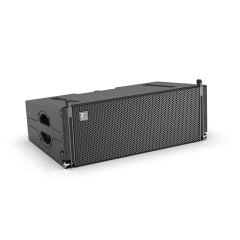When it comes to setting up a portable line array PA, efficiency is everything – to be maximally effective while keeping the setup time as low as can go requires good planning and organization. The first need is the right spot for your system. Speakers should be placed according to the room size and layout. System is kept at 10ft-15ft to the ground so that it reaches a wide area without any obstruction for outdoor events of medium size. Correct positioning is important because research has shown that raising speakers can minimize the ground's sound reflections making music clearer.
This is another important consideration with power management. Regardless of system, a good-sized line array requires between 500 and 1'000 watts per speaker module to provide enough performance for an average-size gig. It is important to make sure that the power source will be able to handle this load without interruptions. For example, a system with four 500-watt speakers would likely require a minimum of 2,000 watts to run continuously for the entire duration of an event. Furthermore, the use of quality cables and at suitable gauges also allows for minimum power loss over distance especially when we are talking about outdoor or large venue settings.
Secondly, The level to which cables can be managed efficiently also determines the ease of setup. Incorporating colour-coded or labelled cables can minimise the time individuals have to spend identifying and connecting elements Consequently, a common arrangement consists of using shorter cabling to connect stacked speakers and use longer cables for connections to the mixer or source, in order that they ar lighter manageable with less potential trip hazards. Such as a 25 foot cable for the mixer at front of house placed to mix or and other such analog device that is happening in close proximity on stage. (flexible but clean) ***ARPAGE
Proper calibration of system is an essential step to assure that the portable line array PA System will work at it best This means fine tuning the EQ settings of a system in order for it to sound its best according to the natural acoustics already present in any given room. Boosting low-end frequencies a tad can make the sound fuller, as there are no walls for it to bounce off of in an open-air environment. Calibration is easy so long as the measurement system contains built-in digital signal processing (DSP) for combining preset EQ settings to different site presets which includes applicable adjustments. A good example (and the one I prefer to use) is present in something like JBL EON ONE Compact: presets that will adjust settings quickly for several acoustics scenarios.

Another important point is efficient setup which requires the rigging, and also speaker alignment or such setups. Properly aligning each speaker in the array can significantly increase sound coverage and decrease issues like phase cancellation. Both top speaker modules should be slightly leaning down, reaching the front side of your audience; and both bottom speakers should have a slight upward tilt to reach further back. Careful alignment reduces zones of clashing sounds and assures the even distribution—especially crucial in oddly shaped or multi-tiered spaces.
Testing the system is a crucial step before initiation of an event. Doing a sound check with the same kind of audio content that will be used at your event gives you an opportunity to identify and fix problems, such as feedback or unbalanced distribution. A complete sound check usually lasts between 15 to 30 minutes (depending on the amount of system and complexity) but that time is saved because it guarantee you have a perfect working system during your gig.
Teardown is as important, if not more than the setup itself. During teardown, make sure you are labeling anything and everything cables going to or from components so the process is quicker and your next setup will be simpler. This often includes organizing cables inside cases using cable ties, and storing them sorted in labeled road-cases to ensure orderliness and avoid breakages while transporting.
The ability to easily transport with portability advantages of a portable line array PA system. Systems such as the Bose L1 Pro16 are built for quick tear-up-and-down use, with modular components that can be assembled and disassembled in minutes. Systems of this type usually each weight in the 40- to 70-lb range, which makes them manageable for one or two people to handle and adds even more efficiency.
Being mindful of location, power management, cable organization as well as system calibration and speaker alignment while also taking a moment to test your portable line array PA System for quality can not only help you get the best sound but it could save diverse problems on event night when suddenly portability becomes an issue.